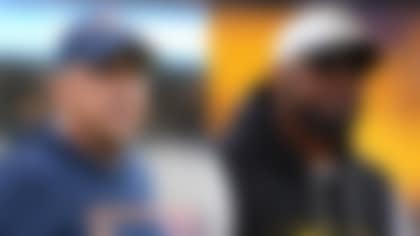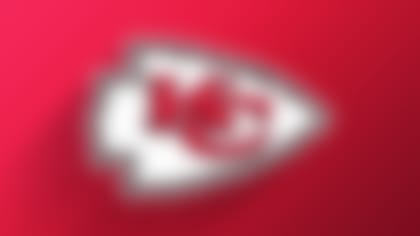The NFL is continuing this March its legacy of more than 40 years of sending players overseas to visit with U.S. military troops. The NFL's Director of Community Affairs David Krichavsky is accompanying three NFL players -- San Diego Chargers defensive end Luis Castillo, Chicago Bears defensive tackle Tommie Harris and Carolina Panthers defensive end Mike Rucker -- and Sports Illustrated/NBC journalist Peter King on a week-long tour to U.S. military bases in Kyrgyzstan and Afghanistan. As he has done before, Krichavsky will file a daily journal covering the trip:
Day 6
There have been countless times during this NFL-USO tour when either the players or the troops that we have met have drawn a parallel between the sport of football and war. After all, the vocabulary is similar -- the blitz, bomb, red zone, shotgun, and many other words are part of both the football and military vernaculars. The attributes necessary for success are virtually identical -- teamwork, tiireless training, precise execution of strategy, etc.
But on Day 6 of the NFL-USO tour, we got a couple of very harsh reminders of how different football and war really are. The consequences of one (winning and losing a game) are meaningless in the context of the other (life or death). We got up close and personal with this when we visited with wounded soldiers at Bagram Hospital, and then even more so when we witnessed a "Fallen Comrade" ceremony in the evening.
The first stop for our group on Day 6 of the trip was the hospital at Bagram Air Base. One of the interesting things about this hospital is that it treats American soldiers and contractors, as well as both Afghani civilians and enemy combatants. It may seem somewhat paradoxical to first shoot at someone and then treat him at your hospital, but our military escort reminded us that captured Taliban soldiers can serve as valuable intelligence sources for us.
At the hospital we spent a good amount of time with four soldiers who had been wounded in an attack on their Humvee only 12 hours earlier. As Specialist Kenneth Pearson of Wyoming explained to me, he and the other soldiers had left their FOB (Fort Operating Base) that morning to patrol the area. Soon after leaving the FOB, the Humvee was ambushed by the enemy, who hit the U.S. soldiers' vehicle with a RPG (Rocket Propelled Grenade).
"When we were hit, everything went white for me," Specialist Pearson explained. "I felt a sharp pain in my neck, and I knew that I was bleeding. My only thought then was fighting back so that our Humvee and the rest of our convoy could get back to the FOB."
Due in large part to the brave response by Specialist Pearson and the three other soldiers in the Humvee, they were able to return enough fire to prevent the rest of the convoy from falling victim to the ambush. All four soldiers in the Humvee sustained significant shrapnel wounds and were airlifted to the hospital at Bagram for treatment. They each received Purple Hearts for their bravery in being wounded in battle.
Later in the day we visited the JOC (Joint Operations Command) at Bagram. As Sergeant Stovall noted, the JOC is the "nerve center for Operation Enduring Freedom," the U.S. war in Afghanistan. At the JOC we met the highest-ranking officer at Bagram, Major General David Rodriguez, as well as the highest-ranking enlisted soldier, Command Sergeant Major Thomas Caple. The NFL group was "coined" by the Bagram leadership, and we once again reciprocated by giving limited edition Super Bowl XLII game coins.
At the JOC, Command Sergeant Major Caple informed us that a U.S. soldier stationed in southern Afghanistan had been killed in an IED attack earlier that day and that there would be a "Fallen Comrade" ceremony at the Bagram airstrip that evening. In the ceremony, the body of this 25-year-old man from California would be loaded onto a plane that would bring him back to the U.S. to be reunited with his family.
At 20:00 that evening, it seemed like the entire base shut down to recognize the soldier's death and participate in the ceremony. Troops lined either side of the street for the entire distance (which was perhaps a mile or so) from the morgue to the airstrip, where the aircraft was ready for takeoff. As a military band played a solemn tune, the casket was carried the final leg of the journey to the plane by the members of the deceased soldier's company. The members of the NFL-USO tour had been given the honor and privilege to pay respect to this fallen hero by being part of the group that stood just outside the plane and delivered a final salute before the body was loaded.
Participating in this ceremony was one of the most emotional moments in any of our lives. While it was a difficult transition for all, the players and Peter held a meet-and-greet, and a "football roundtable" following the ceremony. At the beginning of this event, Luis Castillo noted to the 200 or so troops in attendance, "That soldier made the ultimate sacrifice. He did it for his fellow troops. He did it for our country. Most of us can't even comprehend what that's like."
Mike Rucker also got emotional during the meet-and-greet event. When asked what he would remember about his experience overseas, he described how, as our group toured offices on various bases, we would see support letters sent from schoolchildren back in the states, or homemade cookies sent in care packages from supportive strangers back home. Mike said that he wanted to do his part going forward - he would continue to find ways to boost the morale of the troops long after he returned home. Full of emotion, Mike's voice broke a couple of times as he said this, leading to a nice ovation from the crowd.
The players on the NFL-USO tour came all this way to applaud the troops, yet this was one case where the troops saluted one of the players.
Day 7
The long trip home from Afghanistan gave the members of the 2008 NFL-USO tour plenty of time to reflect on what we had experienced while overseas. There were so many highlights that come to mind immediately, including, in no particular order:
Visiting with the Special Forces.
Flying on a Blackhawk in Jalalabad and getting an aerial view of the stunning scenery.
Witnessing Tommie sing karaoke at Pete's Tavern at Manas Air Force Base.
Hearing about and seeing the Predator and Reaper airplanes in Kandahar.
Trading bad jokes late into the night in our cabin at Bagram.
Visiting the Pat Tillman USO center.
Meeting the Apache Helicopter pilots at Bagram and testing our skills on the Apache simulator.
But it probably won't be any one specific moment or particular event that the players and Peter will remember as time passes. It will likely be the ordinary one-on-one conversations that occurred so naturally between our players and the troops; and the meals that our group shared with soldiers at various DFACs; and the general sense that just by signing an autograph, snapping a photo, or shaking a hand, the members of our tour brought a break to the daily routine and a lift in spirit to the men and women serving our country.
The members of the 2008 NFL-USO tour began the trip with the goal of boosting the morale of as many U.S. troops as possible. If the troops that we met got one half as much out of the experience as we did, then there is no question this tour can go down as a mission accomplished.



